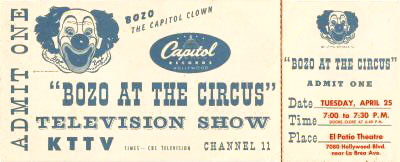Bozo the Clown


Childrens’ records were big business in the forties and fifties, and some of the best were issued on the Capitol label. In 1946, a writer-producer for Capitol named Alan Livingston created the all-time superstar of the genre, Bozo the Clown, and issued the first of many records narrated by Bozo and chronicling his globe-spanning adventures. The material was cleverly-written with full orchestrations and the vocal talents of the original Bozo, Vance “Pinto” Colvig. The multi-talented Mr. Colvig had actually worked as a circus clown in his youth, but had more recently made his career as a cartoon writer and voice actor. He provided the sound of, among other great animated characters, Mr. Disney’s Goofy.
The Bozo records were a huge hit, leading to toys and merchandise, and to Colvig getting painted up in Bozo make-up for personal appearances. In 1949, he became one of the first TV personalities when he hosted a kids’ show on Los Angeles TV for a time. In the years following, other actors were recruited to play Bozo in a wide array of venues and one of them, Larry Harmon, came up with an idea. In 1956, together with a band of investors, he purchased the right to license and package Bozo TV shows across the country. Eventually, Harmon would acquire all rights to the World’s Most Famous Clown and build an industry around him.
The way it worked was that local TV stations throughout the U.S. would license the right to produce a Bozo show in their city, usually employing a local actor who would be properly trained by Harmon’s crew. He would don the rademarked clown make-up, and he’d play games with kids, do little comedy bits, and introduce the Bozo cartoons that Harmon’s animation company produced. The programs went under various names — Bozo’s Circus, Bozo at the Circus, Bozo’s Big Top, et al.
The two most notable franchise operations were on KTLA in Los Angeles, where Vance Colvig, Jr. (son of Pinto) stepped into his father’s oversized shoes from 1959-1964, and WGN in Chicago, where local producers pulled out all stops. Catering to an audience of both kids and adults, the WGN program began in 1961 and featured a live 13-piece band and top circus acts from around the world. A gent named Bob Bell was Chicago’s Bozo until ’84, whereupon comedian Joey D’Auria stepped into those immense shoes and kept folks laughing until the show finally ended in 2001. This ticket is from 1967, which was around the time the show hit its peak in popularity, even spawning a prime-time spin-off called Big Top. (Thanks to George Pappas of WGN for some corrections to this listing.)






